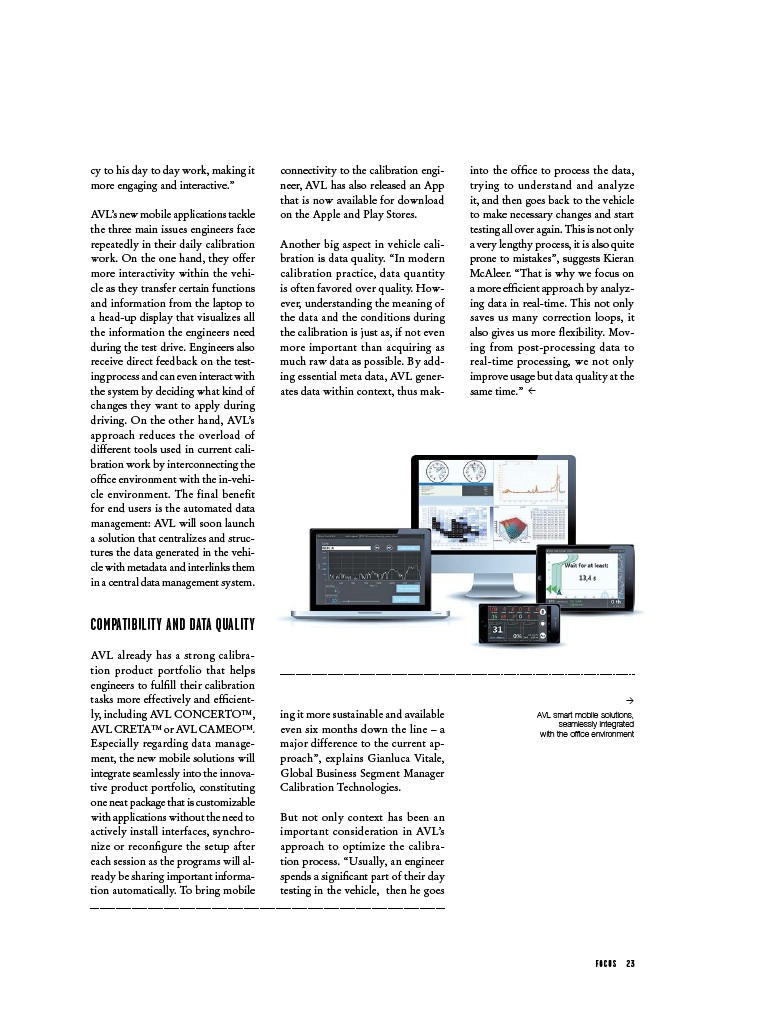
F O C U S 2 3
cy to his day to day work, making it
more engaging and interactive.”
AVL’s new mobile applications tackle
the three main issues engineers face
repeatedly in their daily calibration
work. On the one hand, they offer
more interactivity within the vehicle
as they transfer certain functions
and information from the laptop to
a head-up display that visualizes all
the information the engineers need
during the test drive. Engineers also
receive direct feedback on the testing
process and can even interact with
the system by deciding what kind of
changes they want to apply during
driving. On the other hand, AVL’s
approach reduces the overload of
different tools used in current calibration
work by interconnecting the
office environment with the in-vehicle
environment. The final benefit
for end users is the automated data
management: AVL will soon launch
a solution that centralizes and structures
the data generated in the vehicle
with metadata and interlinks them
in a central data management system.
COMPATIBILITY AND DATA QUALITY
AVL already has a strong calibration
product portfolio that helps
engineers to fulfill their calibration
tasks more effectively and efficiently,
including AVL CONCERTO™,
AVL CRETA™ or AVL CAMEO™.
Especially regarding data management,
the new mobile solutions will
integrate seamlessly into the innovative
product portfolio, constituting
one neat package that is customizable
with applications without the need to
actively install interfaces, synchronize
or reconfigure the setup after
each session as the programs will already
be sharing important information
automatically. To bring mobile
connectivity to the calibration engineer,
AVL has also released an App
that is now available for download
on the Apple and Play Stores.
Another big aspect in vehicle calibration
is data quality. “In modern
calibration practice, data quantity
is often favored over quality. However,
understanding the meaning of
the data and the conditions during
the calibration is just as, if not even
more important than acquiring as
much raw data as possible. By adding
essential meta data, AVL generates
data within context, thus makinto
the office to process the data,
trying to understand and analyze
it, and then goes back to the vehicle
to make necessary changes and start
testing all over again. This is not only
a very lengthy process, it is also quite
prone to mistakes”, suggests Kieran
McAleer. “That is why we focus on
a more efficient approach by analyzing
data in real-time. This not only
saves us many correction loops, it
also gives us more flexibility. Moving
from post-processing data to
real-time processing, we not only
improve usage but data quality at the
same time.” <
>
AVL smart mobile solutions,
seamlessly integrated
with the office environment
ing it more sustainable and available
even six months down the line – a
major difference to the current approach”,
explains Gianluca Vitale,
Global Business Segment Manager
Calibration Technologies.
But not only context has been an
important consideration in AVL’s
approach to optimize the calibration
process. “Usually, an engineer
spends a significant part of their day
testing in the vehicle, then he goes